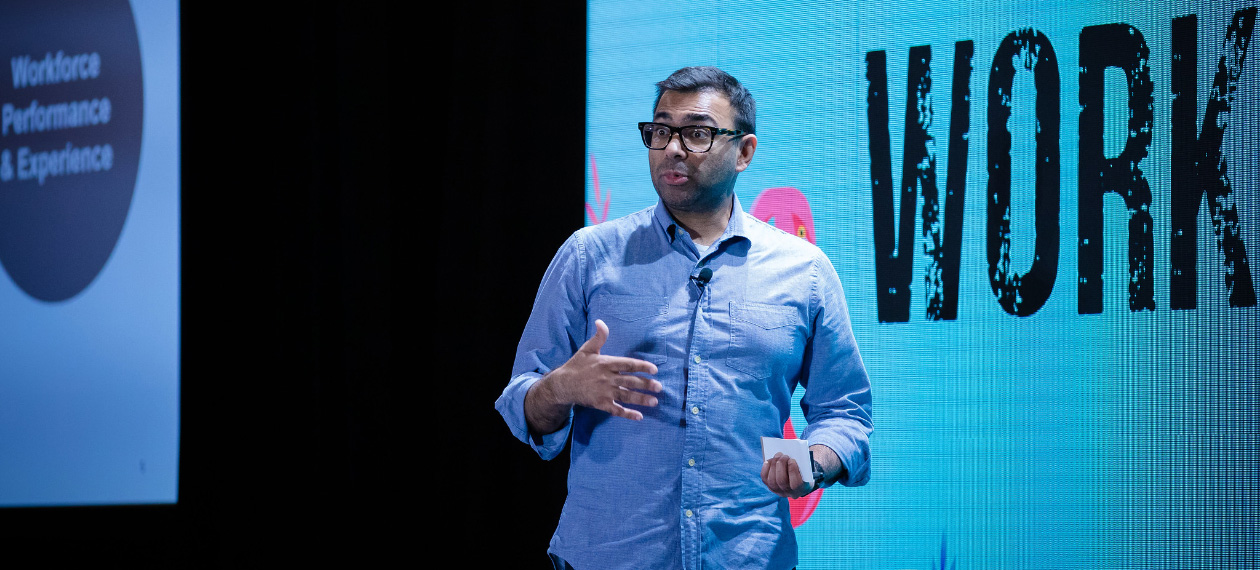At first glance, you might not think a 150-year-old accounting firm would be a global leader in workplace technology. But PricewaterhouseCoopers forces us to look again.
The company has spent the last decade transforming itself into a technology-driven force that aims to put its people—hundreds of thousands of them—first. Sid Bhatia, Director, Workforce of the Future at PwC (part of the company's Real Estate Strategy and Transformation team), shared what they’ve achieved during his talk at WorkSpaces.
Focus on the Workforce Environment, Not the Workplace
Over the last 10 years, PwC took its global staff of then roughly 250,000 people to the cloud over a period of just three years. Also over the last decade, the global staff headcount doubled, the real estate footprint shrank by 40 percent, and employee satisfaction scores related to the workplace increased 26 percent.
More people, less space, and yet higher employee satisfaction ratings.
Bhatia explained this was possible because of one simple distinction: focusing on the workforce environment, not the workplace.
"In the absence of all the great tech we have today, we started looking at building our own utilization and big data platforms," he said. "We built our own hoteling systems from scratch because there was nothing available on the market, and we started to piece this all together with one critical factor in mind: We couldn't forget about our people."
Our daily lives are largely a balancing act between life and work—how can I get in a workout at the gym before I have to head into work, and get my healthy breakfast, and get a good night's sleep, and so on. We typically manage all of this through our smartphones. So how does that translate that into our workday?
"I'm jumping through a series of hoops trying to figure all this stuff out while trying to focus on what my day job looks like and getting to work and focusing on what I need to be focusing on," Bhatia said. This multifaceted modern existence, he continued, is why PwC places so much emphasis on the people, rather than place.
Today's workforce is highly mobile. Skills are more transferable than ever before. Unemployment is at an all-time low and consumerization has taken hold. We're used to having ease and convenience everywhere in our day-to-day lives… except when we're at work.
"There's a disconnect as far as technology goes."
"The expectation is, 'If I can have that at home, why can't I have it at this huge global or national organization that I work for, and why can't I make it seamless so that I can focus on what's really important?' And what's really important from the purpose economy standpoint," Bhatia said. "There's a disconnect as far as technology goes."
If a company is serious about attracting and retaining talent, he added, it needs to prioritize its workforce environment: the connective tissue between an employer and its people, which goes beyond the physical space because work is happening on our laptops, on our tablets, on our phones—everywhere, all the time.
How Tech Can Help
As the concept of "work-life balance" becomes less one of luxury and more an expectation in today's labor market, Bhatia proposed that what we're moving towards looks more like "work-life integration." The right investment in workplace technology can help a highly mobile, readily connected workforce achieve the flexibility of work and work-life balance they desire.
"Work-life integration is having optionality and having choice and having empowerment to decide when I dial up and when I dial back; to decide when to get my work done and still have the flexibility to live my life the way I want to live my life," he said.
 |
| Sid Bhatia, Director of Workforce of the Future for PwC |
Every workplace interaction has a technology component to it: an employee comes in, maybe uses a wayfinding app to find their way around, checks their email, takes phone calls. At work, we are constantly using technology, but the way we use technology is incredibly siloed: we constantly jump from app to app, and those apps are all owned by different companies.
"That is completely at odds with how we're wired as human beings," Bhatia said. "We don’t think through, 'Now I'm in transport mode; now I'm in wayfinding mode.' No, I'm just going through my day. And so it's incumbent on us, the people who are responsible for building work environments, to do so with technologies that are putting people at the center of those experiences."
Additionally, if a company can integrate everything into one app and pull data from that app, it could really get a sense for how their workplace is working for their employees and be able to build terrific workforce environments that employees would love. But there is a "but."
Executing the Value Exchange
We're accustomed to getting certain experiences and conveniences through technology, and we generally have a willingness to sacrifice certain information about ourselves to do so. It's a value proposition we've agreed to, which is why, for all of the alarm-ringing media coverage on data and privacy, we have yet to throw our cell phones into the streets in protest en masse.
"We have to design for people, but we have to do so responsibly."
But between an employer and employee, that value proposition is drastically different. Bhatia said the people designing and implementing human-centric workplace tech must ask themselves, "What is the value exchange?"
"We have to design for people, ultimately, but we have to do so responsibly, and it needs to be based on trust," he said. "Going back to that idea of full employment and the mobility of talent: individuals don't have the loyalty to organizations like they used to, and so they'll walk. We're dealing with a workforce that is quite fickle and ready to jump ship at the drop of a hat."
Organizations need to get ahead of that, he advised, and focus on building environments where people don't feel like they have to come into work, but that they get to come into work. (The latter may be wishful C-suite thinking, but eliminating the former's sense of dread is certainly a worthy and achievable goal.)
Bhatia concluded by saying that the foundation they have laid at PwC over the last 10 years around making their workplaces more mobile, more agile, and more flexible has created a workforce environment in which employees feel more satisfied and fulfilled because their needs come first. For its next innovative, human-centric workplace tech move, PwC is investing $3 billion in digital upskilling for all 276,000+ of its employees worldwide.
"From where I stand in thinking about workplace and workplace technology in the context of people, we're on the cusp of something tremendous, and it goes beyond the physical space," he said. "IT is at the table; HR is at the table. This is becoming a true C-suite topic."

Posted by
Join us at WorkSpaces!
The retreat for corporate real estate and workplace innovators.
Oct 4-6, 2026 | Santa Barbara, CA




-3.png)
-3.png)


-2.png)

Comments